Classroom Dust-Bound Polycyclic Aromatic Hydrocarbons in Jeddah Primary Schools, Saudi Arabia: Level, Characteristics and Health Risk Assessment
Abstract
1. Introduction
2. Materials and Methods
2.1. Sampling Sites and Collection
2.2. Extraction of PAHs in Classroom Dust
2.3. Analysis of PAHs in Classroom Dust
2.4. Sources Identification of PAHs in Classroom Dust
2.5. Health Risk Assessment of PAHs in Classroom Dust
2.5.1. Carcinogenic Potency of PAHs (BaPequi) in Classroom Dust
2.5.2. Carcinogenic Estimation of PAHs in Classroom Dust
2.5.3. Incremental Lifetime Cancer Risk (ILCR) from Exposure to PAHs in Classroom Dust
3. Results and Discussion
3.1. Classroom Dust-Bound PAH Concentrations
3.2. Spatial Variations in Classroom Dust-Bound PAH Concentrations
3.3. Distribution of Classroom Dust-Bound PAHs
3.4. Possible Sources of Classroom Dust-Bound PAHs
3.5. Health Risk Assessment of Classroom Dust-Bound PAH Compounds
3.5.1. Carcinogenic Potency of PAHs (BaPequi)
3.5.2. Carcinogenic PAH Estimation
3.5.3. Incremental Lifetime Cancer Risk (ILCR)
4. Conclusions
Author Contributions
Funding
Acknowledgments
Conflicts of Interest
References
- EEA. Air Quality in Europe—2017 Report; European Environment Agency: Luxembourg, 2017. [Google Scholar]
- Landrigan, P.J.; Fuller, R.; Acosta, N.J.R.; Adeyi, O.; Arnold, R.; Basu, N.; Balde, A.B.; Bertollini, R.; Bose-O’Reilly, S.; Boufford, J.I.; et al. The Lancet Commission on Pollution and Health. Lancet 2017. [Google Scholar] [CrossRef]
- Cohen, A.J.; Brauer, M.; Burnett, R.; Anderson, H.R.; Frostad, J.; Estep, K.; Balakrishnan, K.; Brunekreef, B.; Dandona, L.; Dandona, R.; et al. Estimates and 25-year trends of the global burden of disease attributable to ambient air pollution: An analysis of data from the Global Burden of Diseases Study 2015. Lancet 2017, 389. [Google Scholar] [CrossRef]
- Krugly, E.; Martuzevicius, D.; Sidaraviciute, R.; Ciuzas, D.; Prasauskas, T.; Kauneliene, V.; Stasiulaitiene, I.; Kliucininkas, L. Characterization of particulate and vapor phase polycyclic aromatic hydrocarbons in indoor and outdoor air of primary schools. Atmos. Environ. 2014, 82, 298–306. [Google Scholar] [CrossRef]
- Han, Y.M.; Bandowe, B.A.M.; Wei, C.; Cao, J.J.; Wilcke, W.; Wang, G.H.; Ni, H.Y.; Jin, Z.D.; An, Z.S.; Yan, B.Z. Stronger association of polycyclic aromatic hydrocarbons with soot than with char in soils and sediments. Chemosphere 2015, 119, 1335–1345. [Google Scholar] [CrossRef] [PubMed]
- Dat, N.-D.; Chang, M.B. Review on characteristics of PAHs in atmosphere, anthropogenic sources and control technologies. Sci. Total Environ. 2017, 609, 682–693. [Google Scholar] [CrossRef] [PubMed]
- Tsapakis, M.; Stephanou, E.G. Occurrence of gaseous and particulate polycyclic aromatic hydrocarbons in the urban atmosphere: Study of sources and ambient temperature effect on the gas/particle concentration and distribution. Environ. Pollut. 2005, 133, 47–56. [Google Scholar] [CrossRef]
- Kameda, T. Atmospheric chemistry of polycyclic aromatic hydrocarbons and related compounds. J. Health Sci. 2011, 57, 504–511. [Google Scholar] [CrossRef]
- Haritash, A.K.; Kaushik, C.P. Biodegradation aspects of polycyclic aromatic hydrocarbons (PAHs): A review. J. Hazard. Mater. 2009, 169, 1–15. [Google Scholar] [CrossRef]
- Rosbach, J.T.M.; Vonk, M.; Duijm, F.; van Ginkel, J.T.; Gehring, U.; Brunekreef, B. A ventilation intervention study in classrooms to improve indoor air quality: The FRESH study. Environ. Health 2013, 12, 110–120. [Google Scholar] [CrossRef]
- ATSDR. Toxicological Profile for Polycyclic Aromatic Hydrocarbons, Atlanta, Agency for Toxic Substances and Disease Registry. Available online: https://www.atsdr.cdc.gov/toxprofiles/tp69-p.pdf (accessed on 17 April 2020).
- IARC Working Group on the Evaluation of Carcinogenic Risks to Humans. Some Non-Heterocyclic Polycyclic Aromatic Hydrocarbons and Some Related Exposures; IARC Monographs on the Evaluation of Carcinogenic Risks to Humans; IARC: Lyon, France, 2010; Volume 92. [Google Scholar]
- World Health Organization (WHO). Guidelines for Indoor Air Quality: Selected Pollutants; World Health Organization, Regional Office for Europe: Copenhagen, Denmark, 2010. [Google Scholar]
- World Health Organization (WHO). State of the Science of Endocrine Disrupting Chemicals 2012; United Nations Environment Programme: Geneva, Switzerland; World Health Organization: Geneva, Switzerland, 2013. [Google Scholar]
- Yang, Q.; Chen, H.; Li, B. Polycyclic aromatic hydrocarbons (PAHs) in indoor dusts of Guizhou, southwest of China: Status, Source, and potential human health risk. PLoS ONE 2015, 10, e0118141. [Google Scholar] [CrossRef]
- IARC (International Agency for Research on Cancer). IARC Monographs on the Evaluation of Carcinogenic Risks to Humans, Volume 1–120. 2019. Available online: https://monographs.iarc.fr/monographs-available/ (accessed on 14 August 2019).
- Orecchio, S.; Amorello, D.; Barreca, S.; Valenti, A. Wood pellets for home heating can be considered environmentally friendly fuels? Polycyclic aromatic hydrocarbons (PAHs) in their ashes. Microchem. J. 2016, 124, 267–271. [Google Scholar] [CrossRef]
- Hassan, S.K. Particle-Bound Polycyclic Aromatic Hydrocarbon in the Atmosphere of Heavy Traffic Areas in Greater Cairo, Egypt: Status, Source, and Human Health Risk Assessment. Atmosphere 2018, 9, 368. [Google Scholar] [CrossRef]
- Zhang, L.L.; Yang, L.; Zhou, Q.Y.; Zhang, X.; Xing, W.L.; Wei, Y.J.; Hu, M.; Zhao, L.X.; Akira, T.; Hayakawa, K.; et al. Size distribution of particulate polycyclic aromatic hydrocarbons in fresh combustion smoke and ambient air: A review. J. Environ. Sci. 2020, 88, 370–384. [Google Scholar] [CrossRef] [PubMed]
- Samburova, V.; Connolly, J.; Gyawali, M.; Yatavelli, R.L.N.; Watts, A.C.; Chakrabarty, R.K.; Zielinska, B.; Moosmüller, H.; Khlystov, A. Polycyclic aromatic hydrocarbons in biomass-burning emissions and their contribution to light absorption and aerosol toxicity. Sci. Total Environ. 2016, 568, 391–401. [Google Scholar] [CrossRef] [PubMed]
- Sarigiannis, D.A.; Karakitsios, S.P.; Zikopoulos, D.; Nikolaki, S.; Kermenidou, M. Lung cancer risk from PAHs emitted from biomass combustion. Environ. Res. 2015, 137, 147–156. [Google Scholar] [CrossRef]
- Castro, D.; Slezakova, K.; Delerue-Matos, C.; Alvim-Ferraz, M.C.; Morais, S.; Pereira, M.C. Polycyclic aromatic hydrocarbons in gas and particulate phases of indoor environments influenced by tobacco smoke: Levels, phase distributions and health risk. Atmos. Environ. 2011, 45, 1799–1808. [Google Scholar] [CrossRef]
- Qi, H.; Li, W.L.; Zhu, N.Z.; Ma, W.L.; Liu, L.Y.; Zhang, F.; Li, Y.F. Concentrations and sources of polycyclic aromatic hydrocarbons in indoor dust in China. Sci. Total Environ. 2014, 491–492, 100–107. [Google Scholar] [CrossRef]
- Shen, G.; Wei, S.; Zhang, Y.; Wang, R.; Wang, B.; Li, W.; Shen, H.; Huang, Y.; Chen, Y.; Chen, H.; et al. Emission of oxygenated polycyclic aromatic hydrocarbons from biomass pellet burning in a modern burner for cooking in China. Atmos. Environ. 2012, 60, 234–237. [Google Scholar] [CrossRef]
- Slezakova, K.; Castro, D.; Delerue-Matos, C.; Morais, S.; Pereira, M.C. Levels and risks of particulate-bound PAHs in indoor air influenced by tobacco smoke: A field measurement. Environ. Sci. Pollut. Res. 2014, 21, 4492–4501. [Google Scholar] [CrossRef]
- Chen, Y.; Shen, G.; Huang, Y.; Zhang, Y.; Han, Y.; Wang, R.; Shen, H.; Su, S.; Lin, N.; Zhu, D.; et al. Household air pollution and personal exposure risk of polycyclic aromatic hydrocarbons among rural residents in Shanxi, China. Indoor Air 2016, 26, 246–258. [Google Scholar] [CrossRef]
- Ravindra, K.; Sokhi, R.; Grieken, R.V. Atmospheric polycyclic aromatic hydrocarbons: Source attribution, emission factors and regulation. Atmos. Environ. 2008, 42, 2895–2921. [Google Scholar] [CrossRef]
- Orecchio, S. Polycyclic aromatic hydrocarbons (PAHs) in indoor emission from decorative candles. Atmos. Environ. 2011, 45, 1888–1895. [Google Scholar] [CrossRef]
- Wu, F.; Liu, X.; Wang, W.; Man, Y.B.; Chan, C.Y.; Liu, W.; Tao, S.; Wong, M.H. Characterization of particulate-bound PAHs in rural households using different types of domestic energy in Henan Province, China. Sci. Total Environ. 2015, 536, 840–846. [Google Scholar] [CrossRef] [PubMed]
- Mohai, P.; Kweon, B.S.; Lee, S.; Ard, K. Air pollution around schools is linked to poorer student health and academic performance. J. Epidemiol. Community Health 2011, 65, 852–862. [Google Scholar] [CrossRef] [PubMed]
- Gilliland, F.D. Outdoor air pollution, genetic susceptibility, and asthma management: Opportunities for intervention to reduce the burden of asthma. Pediatrics 2009, 123 (Suppl. 3), S168–S173. [Google Scholar] [CrossRef]
- Pohl, H.R.; Abadin, H.G. Chemical mixtures: Evaluation of risk for child specific exposures in a multi-stressor environment. Toxicol. Appl. Pharmacol. 2008, 233, 116–125. [Google Scholar] [CrossRef]
- Carpente, D.O.; Bushkin-Bedient, S. Exposure to chemicals and radiation during childhood and risk for cancer later in life. J. Adolesc. Health 2013, 52 (Suppl. 5), S21–S29. [Google Scholar] [CrossRef]
- Vedham, V.; Verma, M.; Mahabir, S. Early-life exposures to infectious agents and later cancer development. Cancer Med. 2015, 4, 1908–1922. [Google Scholar] [CrossRef]
- Romagnoli, P.; Balducci, C.; Perilli, M.; Gherardi, M.; Gordiani, A.; Gariazzo, C.; Gatto, M.P.; Cecinato, A. Indoor PAHs at schools, homes and offices in Rome, Italy. Atmos. Environ. 2014, 92, 51–59. [Google Scholar] [CrossRef]
- Jyethi, D.S.; Khillare, P.S.; Sarkar, S. Risk assessment of inhalation exposure to polycyclic aromatic hydrocarbons in school children. Environ. Sci. Pollut. Res. 2014, 21, 366–378. [Google Scholar] [CrossRef]
- Ruchirawat, M.; Settachan, D.; Navasumrit, P.; Tuntawiroon, J.; Autrup, H. Assessment of potential cancer risk in children exposed to urban air pollution in Bangkok, Thailand. Toxicol. Lett. 2007, 168, 200–209. [Google Scholar] [CrossRef] [PubMed]
- Eiguren-Fernandez, A.; Avol, E.L.; Thurairatnam, S.; Hakami, M.; Froines, J.R.; Miguel, A.H. Seasonal influence on vapor-and particle-phase polycyclic aromatic hydrocarbon concentrations in school communities located in southern California. Aerosol Sci. Technol. 2007, 41, 438–446. [Google Scholar] [CrossRef]
- Huang, M.; Wang, W.; Chan, C.Y.; Cheung, K.C.; Man, Y.B.; Wang, X.; Wong, M.H. Contamination and risk assessment (based on bioaccessibility via ingestion and inhalation) of metal (loid)s in outdoor and indoor particles from urban centers of Guangzhou, China. Sci. Total Environ. 2014, 479, 117–124. [Google Scholar] [CrossRef] [PubMed]
- Verdenelli, M.C.; Cecchini, C.; Orpianesi, C.; Dadea, G.M.; Cresci, A. Efficacy of antimicrobial filter treatments on microbial colonization of air panel filters. J. Appl. Microbiol. 2003, 94, 9–15. [Google Scholar] [CrossRef]
- Butte, W.; Heinzow, B. Pollutants in House Dust as Indicators of Indoor Contamination; Reviews of Environmental Contamination and Toxicology; Springer: Berlin/Heidelberg, Germany, 2002. [Google Scholar]
- Gramotnev, G.; Ristovski, Z. Experimental investigation of ultra-fine particle size distribution near a busy road. Atmos. Environ. 2004, 38, 1767–1776. [Google Scholar] [CrossRef]
- Morawska, L.; Salthammer, T. (Eds.) Indoor Environment: Airborne Particles and Settled Dust; Wiley-VCH: Weinheim, Germany, 2003. [Google Scholar]
- See, S.W.; Karthikeyana, S.; Balasubramanian, R. Health risk assessment of occupational exposure to particulate-phase polycyclic aromatic hydrocarbons associated with Chinese, Malay and Indian cooking. J. Environ. Monit. 2006, 8, 369–376. [Google Scholar] [CrossRef]
- Alghamdi, M.A.; Hassan, S.K.; Alzahrani, N.A.; Almehmadi, F.M.; Khoder, M.I. Risk Assessment and Implications of Schoolchildren Exposure to Classroom Heavy Metals Particles in Jeddah, Saudi Arabia. Int. J. Environ. Res. Public Health 2019, 16, 5017. [Google Scholar] [CrossRef]
- United States Environmental Protection Agency (USEPA). Method3540C: Soxhlet Extraction; US Environmental Protection Agency: Washington, DC, USA, 1996.
- Park, J.S.; Wada, T.L.; Sweet, S. Atmospheric distribution of polycyclic aromatic hydrocarbons and deposition to Galveston Bay, Texas, USA. Atmos. Environ. 2001, 35, 3241–3249. [Google Scholar] [CrossRef]
- Lee, J.Y.; Kim, Y.P.; Kang, C.H.; Ghim, Y.S.; Kaneyasu, N. Temporal trend and long-range transport of particulate polycyclic aromatic hydrocarbons at Gosan in northeast Asia between 2001 and 2004. J. Geophys. Res. 2006, 111. [Google Scholar] [CrossRef]
- Lee, J.Y.; Kim, Y.P.; Kang, C.H. Characteristics of the ambient particulate PAHs at Seoul, a mega city of Northeast Asia in comparison with the characteristics of a background site. Atmos. Res. 2011, 99, 50–56. [Google Scholar] [CrossRef]
- Shabbaj, I.I.; Alghamdi, M.A.; Khoder, M.I. Street Dust—Bound Polycyclic Aromatic Hydrocarbons in a Saudi Coastal City: Status, Profile, Sources, and Human Health Risk Assessment. Int. J. Environ. Res. Public Health 2018, 15, 2397. [Google Scholar] [CrossRef]
- Fang, G.C.; Chang, C.N.; Wu, Y.S.; Fu, P.P.C.; Yang, I.L.; Chen, M.H. Characterization, identification of ambient air and road dust polycyclic aromatic hydrocarbons in central Taiwan, Taichung. Sci. Total Environ. 2004, 327, 135–146. [Google Scholar] [CrossRef] [PubMed]
- Bourotte, C.; Forti, M.C.; Taniguchi, S.; Caruso, M.; Lotufo, P.A. A wintertime study of PAHs in fine and coarse aerosols in Sao Paulo City, Brazil. Atmos. Environ. 2005, 39, 3799–3811. [Google Scholar] [CrossRef]
- Guo, Y.; Wu, K.; Huo, X.; Xu, X. Sources, distribution, and toxicity of polycyclic aromatic hydrocarbons. J. Environ. Health 2011, 73, 22–25. [Google Scholar] [PubMed]
- Grimmer, G.; Jacob, J.; Naujack, K.W.; Dettbarn, G. Determination of polycyclic aromatic compounds emitted from brown-coal-fired residential stoves by gas chromatography/gas spectrometry. Anal. Chem. 1983, 55, 892–900. [Google Scholar] [CrossRef]
- Gogou, A.; Stratigakis, N.; Kanakidou, M.; Stefanou, E.G. Organic aerosols in Eastern Mediterranean: Components source reconciliation by using molecular markers and atmospheric back trajectories. Org. Geochem. 1996, 25, 79–96. [Google Scholar] [CrossRef]
- Kavouras, I.G.; Koutrakis, P.; Tsapakis, M.; Lagoudaki, E.; Stephanou, E.G.; Von Baer, D.; Oyola, P. Source apportionment of urban particulate aliphatic and polynuclear aromatic hydrocarbons (PAHs) using multivariate methods. Environ. Sci. Technol. 2001, 35, 2288–2294. [Google Scholar] [CrossRef]
- Khalili, N.R.; Scheff, P.A.; Holsen, T.M. PAH source fingerprints for coke ovens, diesel and gasoline engines, highway tunnels, and wood combustion emissions. Atmos. Environ. 1995, 29, 533–542. [Google Scholar] [CrossRef]
- Pio, C.A.; Alves, C.A.; Duarte, A.C. Identification, abundance and origin of atmospheric organic particulate matter in a Portuguese rural area. Atmos. Environ. 2001, 35, 1365–1568. [Google Scholar] [CrossRef]
- Li, C.K.; Kamens, R.M. The use of polycyclic aromatic hydrocarbons as source signatures in receptor modelling. Atmos. Environ. 1993, 27, 523–532. [Google Scholar] [CrossRef]
- Zhang, W.; Zhang, S.; Wan, C.; Yue, D.; Ye, Y.; Wang, X. Source diagnostics of polycyclic aromatic hydrocarbons in urban road runoff, dust, rain and canopy through fall. Environ. Pollut. 2008, 153, 594–601. [Google Scholar] [CrossRef] [PubMed]
- Rogge, W.F.; Hildemann, L.M.; Mazurek, M.A.; Cass, G.R.; Simoneit, B.R.T. Sources of fine organic aerosol. 2. Noncatalyst and catalystequipped automobiles and heavy-duty diesel trucks. Environ. Sci. Technol. 1993, 27, 636–651. [Google Scholar] [CrossRef]
- Rogge, W.F.; Hildemann, L.M.; Mazurek, M.A.; Cass, G.R.; Simoneit, B.R.T. Sources of fine organic aerosol. 3. Road dust, tire debris and organometallic brake lining dust: Roads as sources and sinks. Environ. Sci. Technol. 1993, 27, 1892–1904. [Google Scholar] [CrossRef]
- Oda, J.; Nomura, S.; Yasuhara, A.; Shibamoto, T. Mobile sources of atmospheric polycyclic aromatic hydrocarbons in a roadway tunnel. Atmos. Environ. 2001, 35, 4819–4827. [Google Scholar] [CrossRef]
- Yunker, M.B.; Macdonald, R.W.; Vingarzan, R.; Mitchell, R.H.; Goyette, D.; Sylvestre, S. PAHs in the Fraser River basin: A critical appraisal of PAH ratios as indicators of PAH source and composition. Org. Geochem. 2002, 33, 489–515. [Google Scholar] [CrossRef]
- Baumard, P.; Budzinski, H.; Michon, Q.; Garrigues, P.; Burgeot, T.; Bellocq, J. Origin and bioavailability of PAHs in the Mediterranean Sea from mussel and sediment. Estuar. Coast. Shelf Sci. 1998, 47, 77–90. [Google Scholar] [CrossRef]
- Caricchia, A.M.; Chiavarini, S.; Pessa, M. Polycyclic aromatic hydrocarbons in the urban atmospheric particulate matter in the city of Naples (Italy). Atmos. Environ. 1999, 33, 3731–3738. [Google Scholar] [CrossRef]
- Gope, M.; Masto, R.E.; George, J.; Balachandran, S. Exposure and cancer risk assessment of polycyclic aromatic hydrocarbons (PAHs) in the street dust of Asansol city, India. Sustain. Cities Soc. 2018, 38, 616–626. [Google Scholar] [CrossRef]
- Hussain, K.; Rahman, M.; Prakash, A.; Hoque, R.R. Street dust bound PAHs, carbon and heavy metals in Guwahati city-seasonality: Toxicity and sources. Sustain. Cities Soc. 2015, 19, 17–25. [Google Scholar] [CrossRef]
- Jiang, Y.; Hua, X.; Yves, U.J.; Zhan, H.; Wu, Y. Status, source and health risk assessment of polycyclicaromatic hydrocarbons in street dust of an industrial city, NW China. Ecotoxicol. Environ. Saf. 2014, 106, 11–18. [Google Scholar] [CrossRef]
- Nisbet, C.; La Goy, P. Toxic Equivalency factors (TEFs) for polycyclic aromatic hydrocarbons (PAHs). Regul. Toxicol. Pharm. 1992, 16, 290–300. [Google Scholar] [CrossRef]
- US Environmental Protection Agency (USEPA). Human health evaluation manual (Part B, development of risk-based preliminary remediation goals). In Risk Assessment Guidance for Superfund; US Environmental Protection Agency: Washington, DC, USA, 1991. [Google Scholar]
- Wang, Z. Regional Study on Soil Polycyclic Aromatic Hydrocarbons in Liaoning: Patterns, Sources and Cancer Risks. Ph.D. Thesis, Dalian University of Technology, Dalian, China, 2007. [Google Scholar]
- Keshavarzi, B.; Sajjad Abbasi, H.; Moore, F.; Delshab, H.; Soltani, N. Polycyclic aromatic hydrocarbons in Street Dust of Bushehr City, Iran: Status, source, and human health risk assessment. Polycycl. Aromat. Compd. 2020, 40, 61–75. [Google Scholar] [CrossRef]
- Petry, T.; Schmid, P.; Schlatter, C. The use of toxic equivalency factors in assessing occupational and environmental health risk associated with exposure to airborne mixtures of polycyclic aromatic hydrocarbons (PAHs). Chemosphere 1996, 32, 639–648. [Google Scholar] [CrossRef]
- Pufulete, M.; Battershill, J.; Boobis, A.; Fielder, R. Approaches to carcinogenic risk assessment for polycyclic aromatic hydrocarbons: A UK perspective. Regul. Toxicol. Pharmacol. 2004, 40, 54–66. [Google Scholar] [CrossRef]
- International Agency for Research on Cancer (IARC). Overall evaluations of carcinogenicity: An updating of IARC monographs. In IARC Monographson the Evaluation of Carcinogenic Risks to Humans; International Agency for Research on Cancer: Lyon, France, 1987. [Google Scholar]
- US Environmental Protection Agency (USEPA). Child Specific Exposure Factors Handbook; National Center for Environmental Assessment: Washington, DC, USA, 2002. [Google Scholar]
- Wang, W.; Huang, M.-J.; Kang, Y.; Wang, H.-S.; Leung, A.O.W.; Cheung, K.C.; Wong, M.H. Polycyclic aromatic hydrocarbons (PAHs) in urban surface dust of Guangzhou, China: Status, sources and human health risk assessment. Sci. Total Environ. 2011, 409, 4519–4527. [Google Scholar] [CrossRef]
- US Environmental Protection Agency (USEPA). Exposure Factors Handbook Edition; National Center for Environmental Assessment: Washington, DC, USA, 2011. [Google Scholar]
- Duan, X.L.; Tao, S.; Xu, D.Q.; Jiang, Q.J. Exposure Measurement and Health Risk Assessment of Human Exposure to Polycyclic Aromatic Hydrocarbons; China Environmental Science Press: Beijing, China, 2011. [Google Scholar]
- Kumar, M.; Furumai, H.; Kurisu, F.; Kasuga, I. Tracing source and distribution of heavy metals in road dust: Soil and soak away sediment through speciation and isotopic fingerprinting. Geoderma 2013, 211–212, 8–17. [Google Scholar] [CrossRef]
- Ferreira-Baptista, L.; De-Miguel, E. Geochemistry and risk assessment of street dust in Luanda: Angola. A tropical urban environment. Atmos. Environ. 2005, 39, 4501–4512. [Google Scholar] [CrossRef]
- Soltani, N.; Keshavarzi, B.; Moore, F.; Tavakol, T.; Lahijanzadeh, A.R.; Jaafarzadeh, N.; Kermani, M. Ecological and human health hazards of heavy metals and polycyclic aromatic hydrocarbons (PAHs) in street dust of Isfahan metropolis, Iran. Sci. Total Environ. 2015, 505, 712–723. [Google Scholar] [CrossRef]
- Peng, C.; Chen, W.P.; Liao, X.L.; Wang, M.E.; Ouyang, Z.Y.; Jiao, W.T. Polycyclic aromatic hydrocarbons in urban soils of Beijing: Status, sources, distribution and potential risk. Environ. Pollut. 2011, 159, 802–808. [Google Scholar] [CrossRef]
- Dyke, P.H.; Foan, C.; Fiedler, H. PCB and PAH releases from power stations and waste incineration processes in the UK. Chemosphere 2003, 50, 469–480. [Google Scholar] [CrossRef]
- Zielinska, B.; Sagebiel, J.; Arnott, W.P.; Rogers, C.F.; Kelly, K.E.; Wagner, D.A.; Lighty, J.S.; Sarofim, A.F.; Palmer, G. Phase and size distribution of polycyclic aromatic hydrocarbons in diesel and gasoline vehicle emissions. Environ. Sci. Technol. 2004, 38, 2557–2567. [Google Scholar] [CrossRef] [PubMed]
- Amato, F.; Rivas, I.; Viana, M.; Moreno, T.; Bouso, L.; Reche, C.; Àlvarez-Pedrerol, M.; Alastuey, A.; Sunyer, J.; Querol, X. Sources of indoor and outdoor PM2.5 concentrations in primary schools. Sci. Total Environ. 2014, 490, 757–765. [Google Scholar] [CrossRef] [PubMed]
- Moreno, T.; Rivas, I.; Bouso, L.; Viana, M.; Jones, T.; Àlvarez-Pedrerol, M.; Andrés Alastuey, A.; Sunyer, J.; Querol, X. Variations in school playground and classroom atmospheric particulate chemistry. Atmos. Environ. 2014, 91, 162–171. [Google Scholar] [CrossRef]
- Rivas, I.; Viana, M.; Moreno, T.; Pandolfi, M.; Amato, F.; Reche, C.; Bouso, L.; Àlvarez-Pedrerol, M.; Alastuey, A.; Sunyer, J.; et al. Child exposure to indoor and outdoor air pollutants in schools in Barcelona, Spain. Environ. Int. 2014, 69, 200–212. [Google Scholar] [CrossRef] [PubMed]
- Rivas, I.; Viana, M.; Moreno, T.; Bouso, L.; Pandolfi, M.; Àlvarez-Pedrerol, M.; Forns, J.; Alastuey, A.; Sunyer, J.; Querol, X. Outdoor infiltration and indoor contribution of UFP and BC, OC, secondary inorganic ions and metals in PM2.5 in schools. Atmos. Environ. 2015, 106, 129–138. [Google Scholar] [CrossRef]
- Al-Hemoud, A.M.; Al-Awadi, L.; A-Rashidi, M.S.; A-Rashid, M.S.; Khan, A.R.; Alkhayat, A.; Behbehani, W. Comparison of indoor air quality in schools: Urban vs. Industrial ‘oil & gas’ zones in Kuwait. Build. Environ. 2017, 122, 50–60. [Google Scholar]
- Yassin, M.F.; Alhajeri, N.S.; Kassem, M.A. Polycyclic aromatic hydrocarbons collected from indoor built environments on heating, ventilation and air conditioning dust filters. Indoor Built Environ. 2016, 25, 137–150. [Google Scholar] [CrossRef]
- Gunawardena, A.; Egodawatta, P.; Godwin, A.A.; Goonetilleke, A. Role of traffic in atmospheric accumulation of heavy metals and polycyclic aromatic hydrocarbons. Atmos. Environ. 2012, 54, 502–510. [Google Scholar] [CrossRef]
- Cvetkovi, A.; Jovasevic-Stojanovic, M.; Markovic, Z.; Ristovski, D. Concentration and source identification of polycyclic aromatic hydrocarbons in the metropolitan area of Belgrade, Serbia. Atmos. Environ. 2015, 112, 335–343. [Google Scholar] [CrossRef]
- Bian, Q.; Alharbi, B.; Collett Jr., J.; Kreidenweis, S.; Pasha, M.J. Measurements and source apportionment of particle–associated polycyclic aromatic hydrocarbons in ambient air in Riyadh, Saudi Arabia. Atmos. Environ. 2016, 137, 186–198. [Google Scholar] [CrossRef]
- Hassan, S.K.; Khoder, M.I. Gas–particle concentration, distribution, and health risk assessment of polycyclic aromatic hydrocarbons at a traffic area of Giza, Egypt. Environ. Monit. Assess. 2012, 184, 3593–3612. [Google Scholar] [CrossRef] [PubMed]
- Larsen, R.K., 3rd; Baker, J.E. Source apportionment of Polycyclic Aromatic Hydrocarbons in the urban atmosphere: A comparison of three methods. Environ. Sci. Technol. 2003, 37, 1873–1881. [Google Scholar] [CrossRef] [PubMed]
- Odabasi, M.; Vardar, N.; Sofuoglu, A.; Tasdemir, Y.; Holsn, T.M. Polycyclic aromatic hydrocarbons (PAHs) in Chicago air. Sci. Total Environ. 1999, 27, 57–67. [Google Scholar] [CrossRef]
- Cincinelli, A.; Del Bubba, M.; Martellini, T.; Gambaro, A.; Lepri, L. Gas-particle concentration and distribution of n-alkanes and polycyclic aromatic hydrocarbons in the atmosphere of Prato (Italy). Chemosphere 2007, 68, 472–478. [Google Scholar] [CrossRef] [PubMed]
- Fon, T.Y.W.; Noriatsu, O.; Hiroshi, S. Polycyclic aromatic hydrocarbons (PAHs) in the aerosol of higashi hiroshima, Japan: Pollution scenario and source identification. Water Air Soil Pollut. 2007, 182, 235–243. [Google Scholar] [CrossRef]
- Kishida, M.; Imamura, K.; Takenaka, N.; Maeda, Y.; Viet, P.H.; Bandow, H. Concentrations of atmospheric polycyclic aromatic hydrocarbons in particulate matter and the gaseous phase at roadside sites in Hanoi, Vietnam. Bull. Environ. Contam. Toxicol. 2008, 81, 174–179. [Google Scholar] [CrossRef]
- Dahle, S.; Savinov, V.M.; Matishov, G.G.; Evenset, A.; Næs, K. Polycyclic aromatic hydrocarbons (PAHs) in bottom sediments of the Kara Sea shelf, Gulf of Ob and Yenisei Bay. Sci. Total Environ. 2003, 306, 57–71. [Google Scholar] [CrossRef]
- Liu, M.; Cheng, S.B.; Ou, D.N.; Hou, L.J.; Gao, L.; Wang, L.L. Characterization, identification of road dust PAHs in central Shanghai areas, China. Atmos. Environ. 2007, 41, 8785–8795. [Google Scholar] [CrossRef]
- Bandowe, B.A.M.; Nkansah, M.A. Occurrence, distribution and health risk from polycyclic aromatic compounds (PAHs, oxygenated-PAHs and azaarenes) in street dust from a major West African Metropolis. Sci. Total Environ. 2016, 553, 439–449. [Google Scholar] [CrossRef]
- Boonyatumanond, R.; Murakami, M.; Wattayakorn, G.; Togo, A.; Takada, H. Sources of polycyclic aromatic hydrocarbons (PAHs) in street dust in a tropical Asian megacity, Bangkok, Thailand. Sci. Total Environ. 2007, 384, 420–432. [Google Scholar] [CrossRef]
- Lohmann, R.; Northcott, G.L.; Jones, K.C. Assessing the contribution of diffuse domestic burning as a source of PCDD/Fs, PCBs, and PAHs to the U.K. atmosphere. Environ. Sci. Technol. 2000, 34, 2892–2899. [Google Scholar] [CrossRef]
- Ding, X.; Wang, X.M.; Xie, Z.Q.; Xiang, C.H.; Mai, B.X.; Sun, L.G.; Zheng, M.; Sheng, G.Y.; Fu, J.M.; Poschl, U. Atmospheric polycyclic aromatic hydrocarbons observed over the North Pacific Ocean and the Arctic area: Spatial distribution and source identification. Atmos. Environ. 2007, 47, 2061–2072. [Google Scholar] [CrossRef]
- IARC (International Agency for Research on Cancer). A review of human carcinogens—Part F. Chemical agents and related occupations. Lancet Oncol. 2009, 10, 1143–1144. [Google Scholar] [CrossRef]
- Wang, X.L.; Tao, S.; Dawson, R.W.; Xu, F.L. Characterizing and comparing risks of polycyclic aromatic hydrocarbons in a Tianjin wastewater-irrigated area. Environ. Res. 2002, 90, 201–206. [Google Scholar] [CrossRef]
- WHO (World Health Organization). Polynuclear aromatic hydrocarbons. In Air Quality Guidelines for Europe; WHO Regional Publications, European Series No. 23; World Health Organization: Geneva, Switzerland, 1987; pp. 105–117. [Google Scholar]
- IARC (International Agency for Research on Cancer). Air Pollution, Part 1: Some Non-Heterocyclic Polycyclic Aromatic Hydrocarbons and Some Related Industrial Exposures; IARC Monographs on the Evaluation of Carcinogenic Risks to Humans 92; IARC: Lyon, France, 2009. [Google Scholar]
- WHO (World Health Organization). Air Quality Guidelines for Europe; Regional Publications, European Series No. 91; Regional Office for Europe: Copenhagen, Denmark, 2000. [Google Scholar]
- Lin, T.C.; Chang, F.H.; Hsieh, J.H.; Chao, H.R.; Chao, M.R. Characteristics of polycyclic aromatic hydrocarbons and total suspended particulate in indoor and outdoor atmosphere of a Taiwanese temple. J. Hazard. Mater. 2002, 95, 1–12. [Google Scholar] [CrossRef]
- Harrison, R.M.; Smith, D.J.T.; Luhana, L. Source apportionment of atmospheric polycyclic aromatic hydrocarbons collected from an urban location in Birmingham, U.K. Environ. Sci. Technol. 1996, 30, 825–832. [Google Scholar] [CrossRef]
- Fang, G.C.; Wu, Y.S.; Chen, M.H.; Ho, T.T.; Huang, S.H.; Rau, J.Y. Polycyclic aromatic hydrocarbons study in Taichung, Taiwan, during 2002–2003. Atmos. Environ. 2004, 38, 3385–3391. [Google Scholar] [CrossRef]
- Chen, S.; Liao, C. Health risk assessment on human exposed to environmental polycyclic aromatic hydrocarbons pollution sources. Sci. Total Environ. 2006, 366, 112–123. [Google Scholar] [CrossRef]
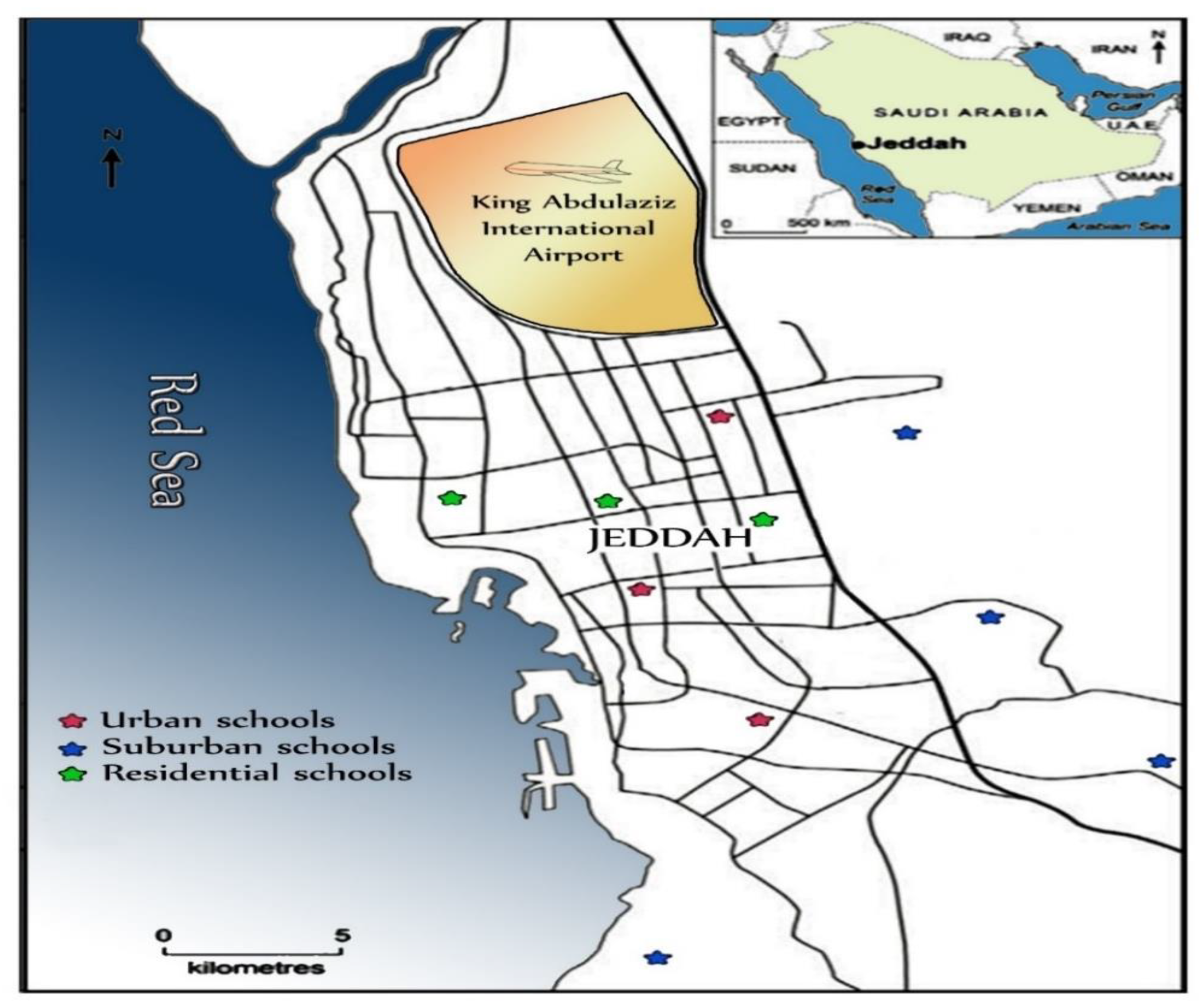
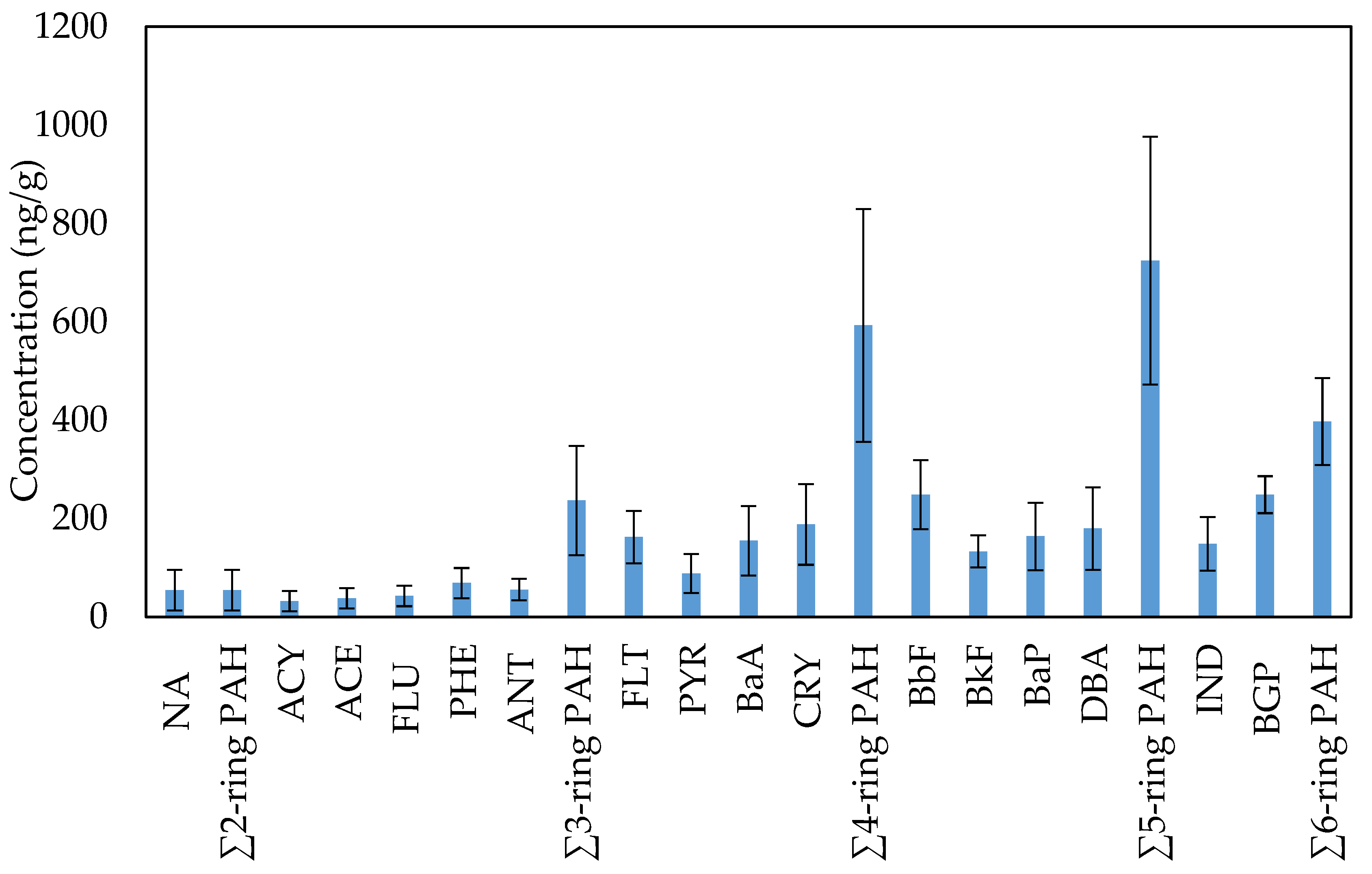
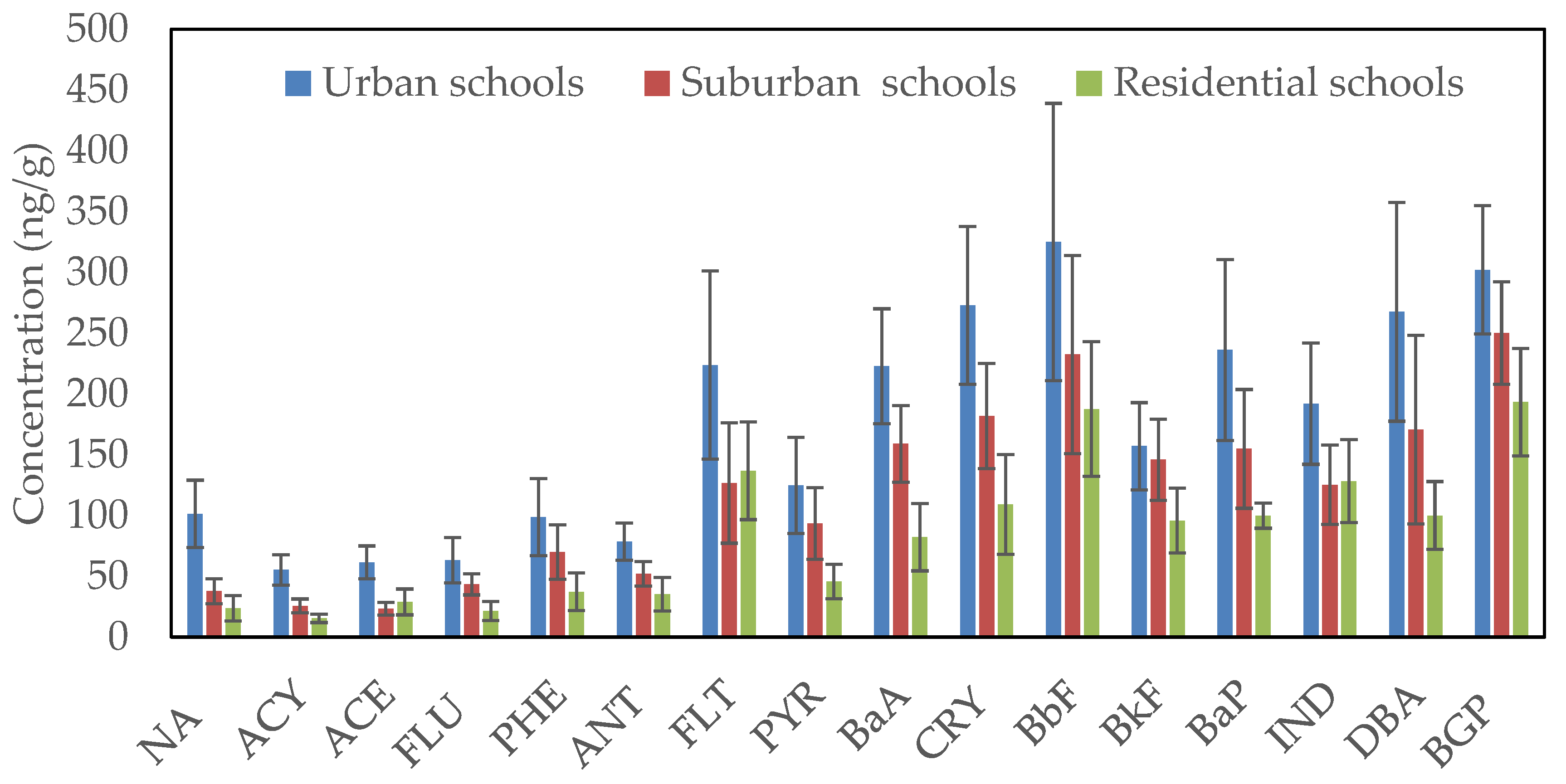
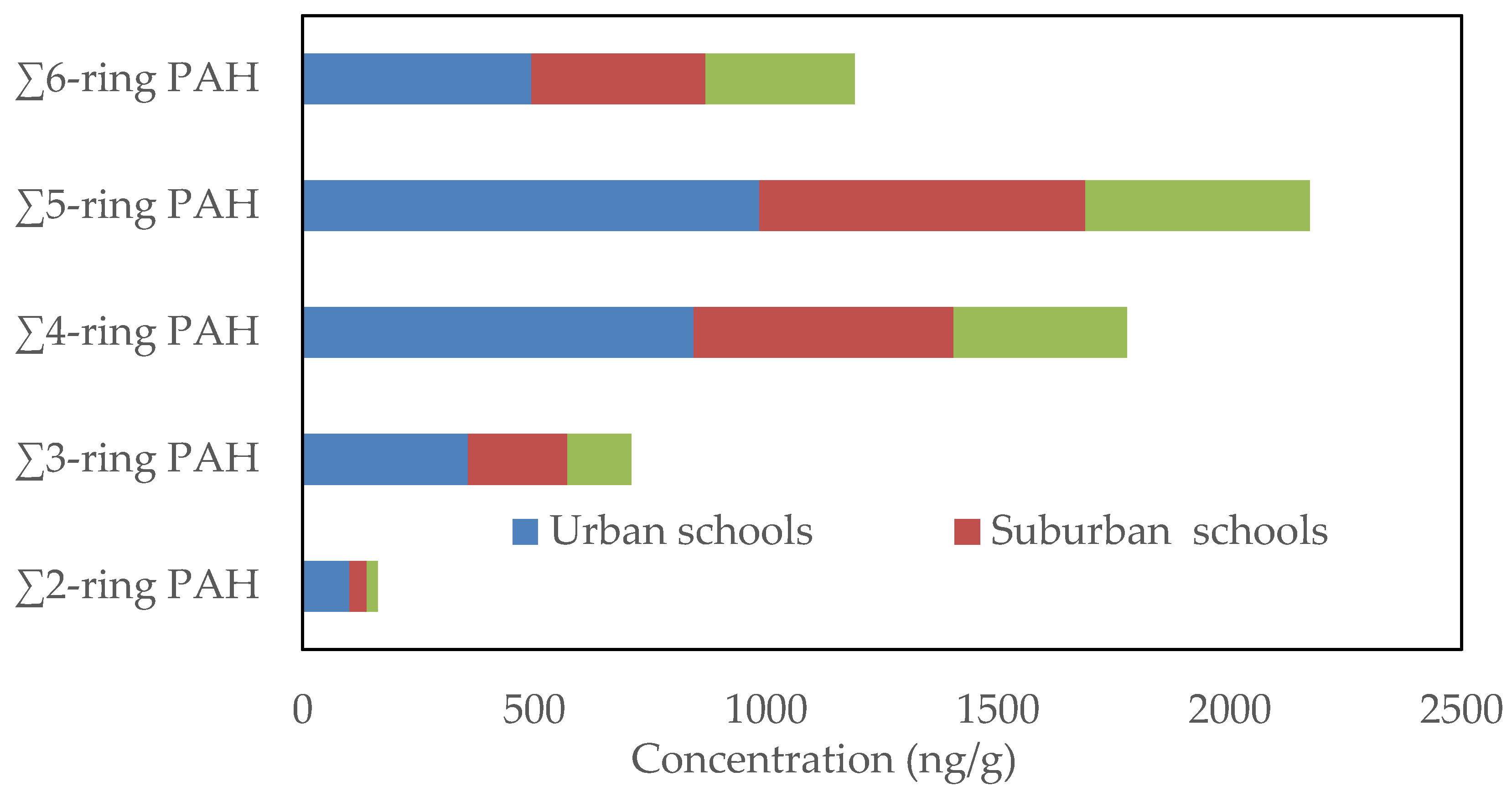
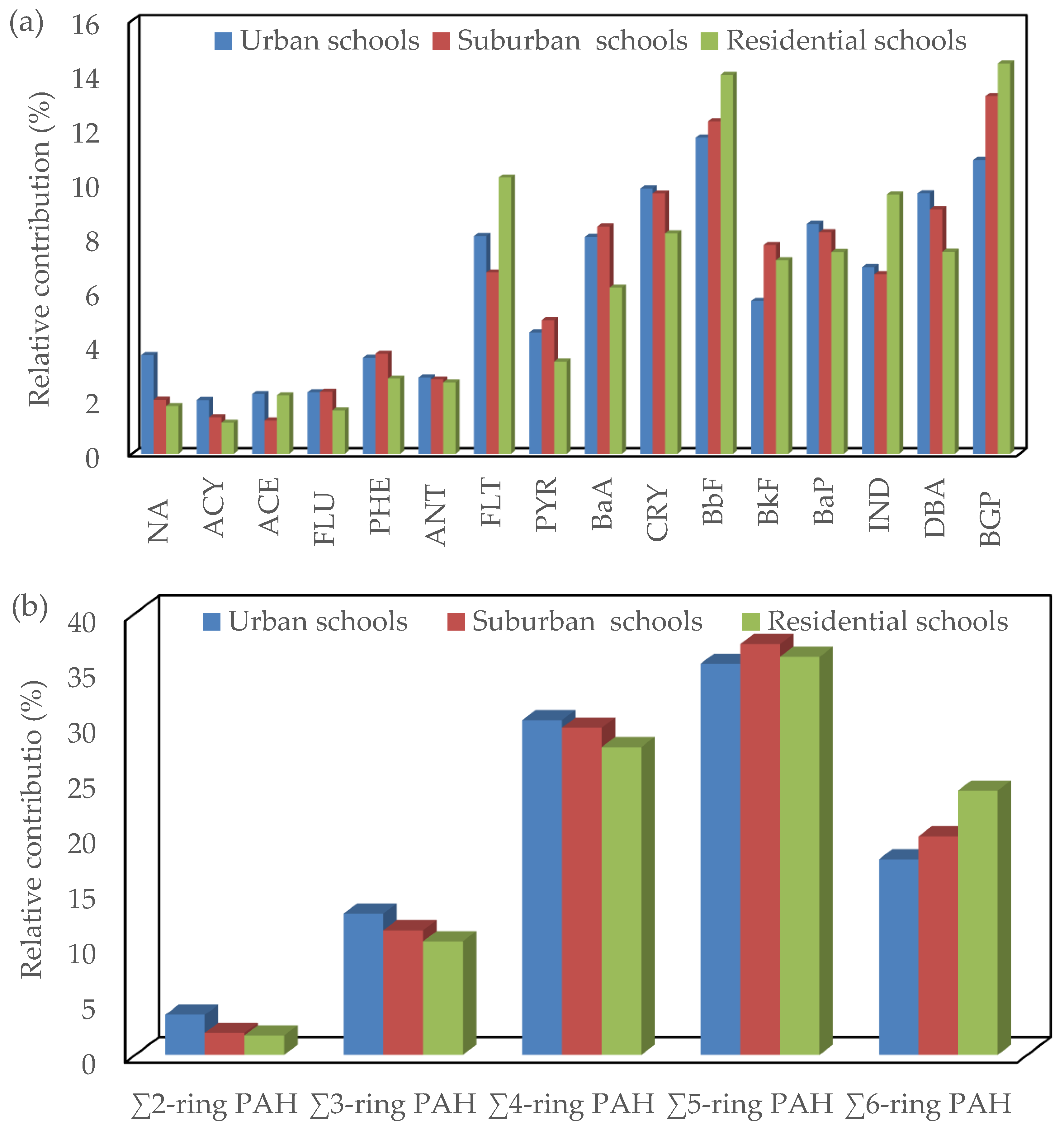


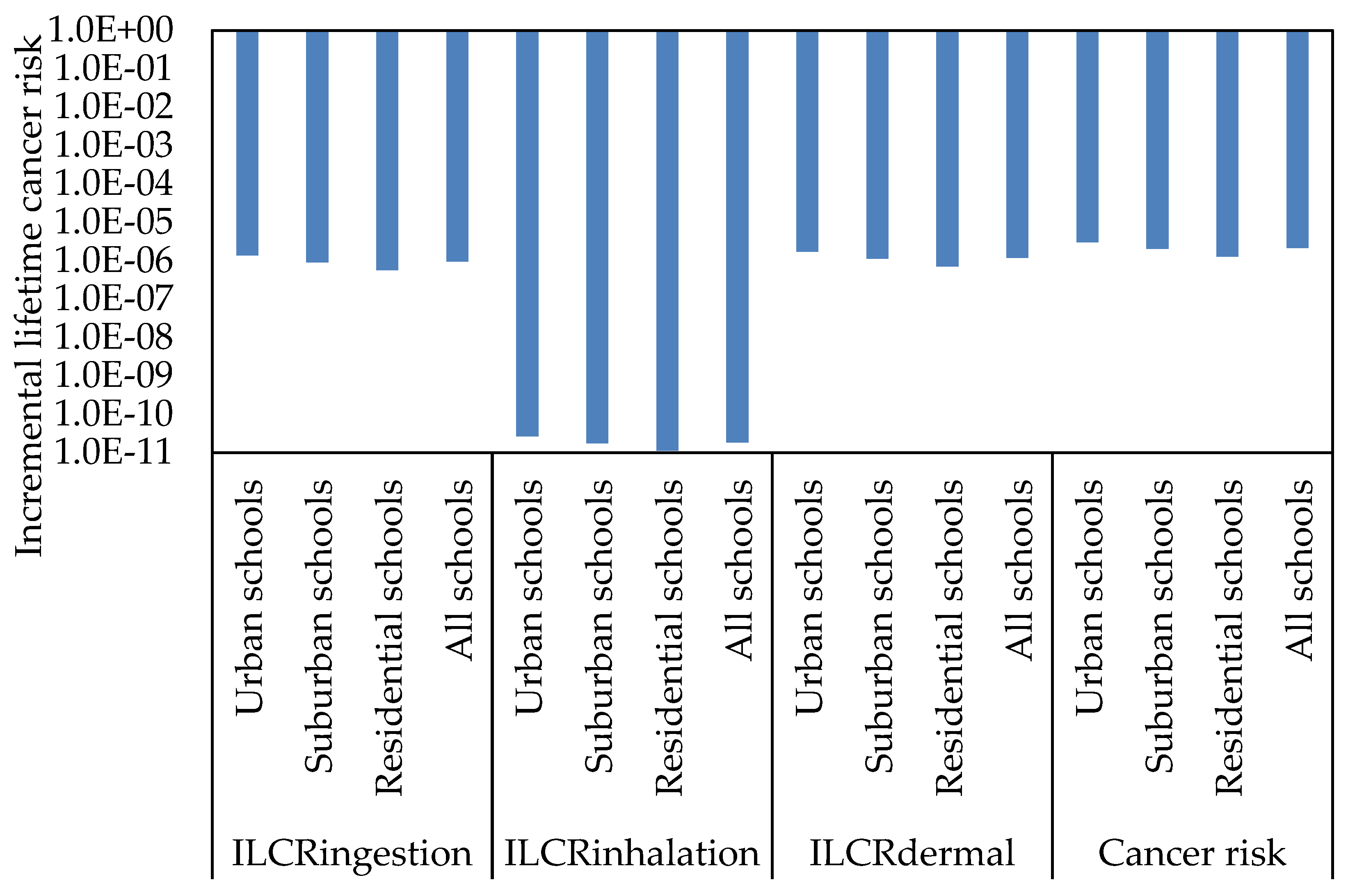
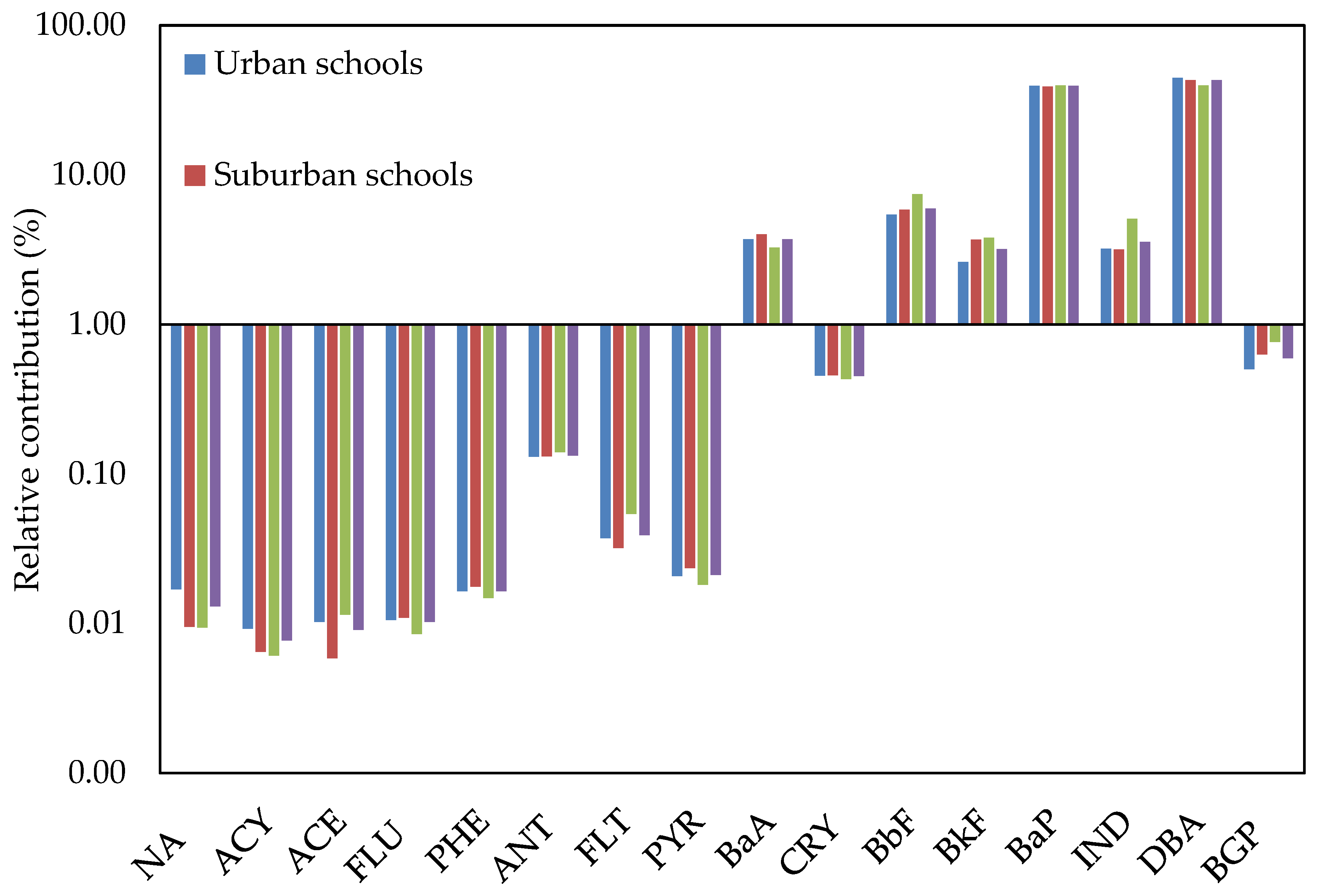
| Exposure Factors | Symbol | Unit | Child | Reference |
|---|---|---|---|---|
| BaPequi. concentration for PAH compounds | Cs | mg BaPequi/kg | Present study | |
| Ingestion rate | IRingestion | mg/day | 200 | [79] |
| Exposed skin area | SA | cm2/day | 2800 | [79] |
| Skin adherence factor | SAF | mg/cm2 | 0.2 | [79,80] |
| Exposure frequency | EF | days/year | 167 | [81] |
| Exposure duration | ED | year | 6 | [79] |
| Body weight | BW | kg | 15 | [71] |
| Averaging time (70 years × 365 days/year) | AT | days | 25,550 | [78,82] |
| Dermal adsorption fraction | ABS | unitless | 0.13 | [79] |
| Inhalation rate | IRinhalation | m3/day | 10 | [83] |
| Particle emission factor | PEF | m3/kg | 1.36 × 109 | [79] |
| Carcinogenic slope factor for ingestion | CSFingestion | mg/kg/day | 7.3 | [84] |
| Carcinogenic slope factor for inhalation | CSFinhalation | mg/kg/day | 3.85 | [84] |
| Carcinogenic slope factor for dermal | CSFdermal | mg/kg/day | 25 | [84] |
| Ratio | Schools | Value | Source | Reference | ||
|---|---|---|---|---|---|---|
| Urban | Suburban | Residential | ||||
| BaA/CRY | 0.82 | 0.87 | 0.75 | 0.28–1.20 | Gasoline engines | [51,52] |
| 0.17–0.36 | Diesel engine | |||||
| IND/(IND + BGP) | 0.39 | 0.33 | 0.4 | 0.21–0.22 | Gasoline cars | [27,53,54,55,56,57,58] |
| 0.35–0.70 | Diesel emissions | |||||
| 0.56 | Coal combustion | |||||
| 0.62 | Wood combustion | |||||
| 0.36 | Road dust | |||||
| BaP/(BaP + CRY) | 0.46 | 0.46 | 0.48 | 0.5 | Diesel | [27] |
| 0.73 | Gasoline | |||||
| FLU/(FLU + PYR) | 0.34 | 0.32 | 0.32 | >0.5 | Diesel | [27] |
| <0.5 | Gasoline | |||||
| BaA/(BaA + CRY) | 0.45 | 0.47 | 0.43 | 1.6 | Diesel cars | [59] |
| 0.33 | Gasoline cars | |||||
| 2.18 | Wood combustion | |||||
| ∑PAHsLMW/∑PAHsHMW | 0.2 | 0.15 | 0.14 | >1 | Petrogenic | [60] |
| <1 | Pyrogenic | |||||
| ∑CPAHs/∑PAHs | 0.74 | 0.78 | 0.8 | <1 | Mobile source | [61] |
| BGP/BaP | 1.28 | 1.61 | 1.93 | 1.2–2.2 | Diesel cars | [61,62,63] |
| 2.5–3.3 | Gasoline cars | |||||
| 0.86, 0.91 | Road dust | |||||
| ANT/(ANT + PHE) | 0.44 | 0.43 | 0.49 | <0.1 | Petroleum source | [64] |
| >0.1 | combustion source | |||||
| PHE/ANT | 1.26 | 1.34 | 1.06 | <10 | Pyrogenic | [65] |
| >15 | Petrogenic | |||||
| FLT/PYR | 1.79 | 1.36 | 2.99 | >1 | Pyrogenic | [65] |
| <1 | Petrogenic | |||||
| IND/BGP | 0.64 | 0.5 | 0.66 | 0.4 | Gasoline engine | [66] |
| ≈1 | Diesel engine | |||||
| PAHs | TEF | Concentration (Urban Schools) | Concentration (Suburban Schools) | Concentration (Residential Schools) | Concentration (All Schools) | ||||
|---|---|---|---|---|---|---|---|---|---|
| ng/g | ng BaPaquiv/g | ng/g | ng BaPaquiv/g | ng/g | ng BaPaquiv/g | ng/g | ng BaPaquiv/g | ||
| NA | 0.001 | 101.34 | 0.10 | 37.73 | 0.04 | 23.64 | 0.02 | 54.24 | 0.05 |
| ACY | 0.001 | 55.24 | 0.06 | 25.58 | 0.03 | 15.35 | 0.02 | 32.06 | 0.03 |
| ACE | 0.001 | 61.35 | 0.06 | 23.27 | 0.02 | 28.86 | 0.03 | 37.83 | 0.04 |
| FLU | 0.001 | 63.34 | 0.06 | 43.36 | 0.04 | 21.41 | 0.02 | 42.71 | 0.04 |
| PHE | 0.001 | 98.59 | 0.10 | 69.84 | 0.07 | 37.28 | 0.04 | 68.57 | 0.07 |
| ANT | 0.010 | 78.54 | 0.79 | 51.99 | 0.52 | 35.23 | 0.35 | 55.25 | 0.55 |
| FLT | 0.001 | 223.64 | 0.22 | 126.62 | 0.13 | 136.75 | 0.14 | 162.34 | 0.16 |
| PYR | 0.001 | 124.67 | 0.12 | 93.35 | 0.09 | 45.68 | 0.05 | 87.90 | 0.09 |
| BaA | 0.100 | 222.75 | 22.28 | 158.84 | 15.88 | 82.17 | 8.22 | 154.59 | 15.46 |
| CRY | 0.010 | 272.79 | 2.73 | 181.80 | 1.82 | 109.08 | 1.09 | 187.89 | 1.88 |
| BbF | 0.100 | 324.89 | 32.49 | 232.36 | 23.24 | 187.49 | 18.75 | 248.24 | 24.82 |
| BkF | 0.100 | 156.96 | 15.70 | 145.89 | 14.59 | 95.75 | 9.58 | 132.87 | 13.29 |
| BaP | 1.00 | 236.10 | 236.10 | 154.76 | 154.76 | 99.89 | 99.89 | 163.58 | 163.58 |
| IND | 0.100 | 191.95 | 19.20 | 125.35 | 12.54 | 128.24 | 12.82 | 148.51 | 14.85 |
| DBA | 1.00 | 267.54 | 267.54 | 170.69 | 170.69 | 99.97 | 99.97 | 179.40 | 179.40 |
| BGP | 0.010 | 302.02 | 3.02 | 250.00 | 2.50 | 193.16 | 1.93 | 248.39 | 2.48 |
| Total carcinogenic activity (TCA) | 600.6 | 397.0 | 252.9 | 416.8 | |||||
| Contribution of BaA to the TCA (%) | 3.71 | 4.00 | 3.25 | 3.71 | |||||
| Contribution of BbFto the TCA (%) | 5.41 | 5.85 | 7.41 | 5.95 | |||||
| Contribution of BkF to the TCA (%) | 2.61 | 3.67 | 3.79 | 3.19 | |||||
| Contribution of BaP to the TCA (%) | 39.31 | 38.98 | 39.50 | 39.25 | |||||
| Contribution of DBA to the TCA (%) | 44.54 | 42.99 | 39.52 | 43.04 | |||||
| Contribution of CRY to the TCA (%) | 0.45 | 0.46 | 0.43 | 0.45 | |||||
| Contribution of IND to the TCA (%) | 3.20 | 3.16 | 5.07 | 3.56 | |||||
© 2020 by the authors. Licensee MDPI, Basel, Switzerland. This article is an open access article distributed under the terms and conditions of the Creative Commons Attribution (CC BY) license (http://creativecommons.org/licenses/by/4.0/).
Share and Cite
Alghamdi, M.A.; Hassan, S.K.; Alzahrani, N.A.; Al Sharif, M.Y.; Khoder, M.I. Classroom Dust-Bound Polycyclic Aromatic Hydrocarbons in Jeddah Primary Schools, Saudi Arabia: Level, Characteristics and Health Risk Assessment. Int. J. Environ. Res. Public Health 2020, 17, 2779. https://doi.org/10.3390/ijerph17082779
Alghamdi MA, Hassan SK, Alzahrani NA, Al Sharif MY, Khoder MI. Classroom Dust-Bound Polycyclic Aromatic Hydrocarbons in Jeddah Primary Schools, Saudi Arabia: Level, Characteristics and Health Risk Assessment. International Journal of Environmental Research and Public Health. 2020; 17(8):2779. https://doi.org/10.3390/ijerph17082779
Chicago/Turabian StyleAlghamdi, Mansour A., Salwa K. Hassan, Noura A. Alzahrani, Marwan Y. Al Sharif, and Mamdouh I. Khoder. 2020. "Classroom Dust-Bound Polycyclic Aromatic Hydrocarbons in Jeddah Primary Schools, Saudi Arabia: Level, Characteristics and Health Risk Assessment" International Journal of Environmental Research and Public Health 17, no. 8: 2779. https://doi.org/10.3390/ijerph17082779
APA StyleAlghamdi, M. A., Hassan, S. K., Alzahrani, N. A., Al Sharif, M. Y., & Khoder, M. I. (2020). Classroom Dust-Bound Polycyclic Aromatic Hydrocarbons in Jeddah Primary Schools, Saudi Arabia: Level, Characteristics and Health Risk Assessment. International Journal of Environmental Research and Public Health, 17(8), 2779. https://doi.org/10.3390/ijerph17082779





